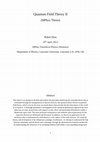Technical Documentation by Rahul K . Dass
The goal of our project was to implement the Radial-Basis Function Network (RBFN) on three domain... more The goal of our project was to implement the Radial-Basis Function Network (RBFN) on three domains of varying sizes, in terms of number of attributes and class labels. In section 2, we discuss how we implemented RBFN. We then explored the UCI repository and restricted the size of each domain dataset to be no larger than a few hundred instances, the details of which will be delineated in section 3. Finally, in section 4 we state our results for each domain, comparing the final testing accuracy by varying total number of hidden neurons and learning rate.
The goal of our project was to compare the behavior of the Perceptron and WINNOW linear classific... more The goal of our project was to compare the behavior of the Perceptron and WINNOW linear classification algorithms when run on various datasets. Specifically, we analyzed the error rate of each algorithm during the training process to get a sense of the rate at which training was occurring. We also captured the total run time and total number of instances trained to see which algorithm was faster.
The driving force behind the evolution of computing from automating automation [3] to automating ... more The driving force behind the evolution of computing from automating automation [3] to automating learning [8] can be attributed to Machine Learning algorithms. By being able to generalize from examples, today's computers have the ability to perform autonomously and take critical decisions in almost any given task. In this report, we briefly discuss some of the foundations of what makes Machine Learning so powerful. Within the realm of supervised learning, we explore one of the most widely used classifi�cation technique known as Decision Tree Learning. We develop and analyze the ID3 algorithm, in particular we demonstrate how concepts such as Shannon's Entropy and Information Gain enables this form of learning to yield such powerful results. Furthermore, we introduce avenues through which the ID3 algorithm can be improved such as Gain ratio and the Random Forest Approach [4].
This report is an attempt to delineate and discuss two major concepts, Java Server Pages and Java... more This report is an attempt to delineate and discuss two major concepts, Java Server Pages and Java Database Connectivity (accomplished through MS Access), implemented by the powerful and dynamic technology called Java 2 Enterprise Edition. A thorough quantitative investigation of this technology is conducted via a novel project that coincidently, focuses on a student’s requirement for a concise representation of the knowledge needed to understand the heart of Java, namely, is the Java 2 Standard Edition.
This report is an attempt to delineate and discuss a technology that is used within Microsoft’s .... more This report is an attempt to delineate and discuss a technology that is used within Microsoft’s .Net framework called Visual Basic.Net. A thorough quantitative investigation is conducted via a project that focuses on a vision of replacing a traditional manual library system, with a simplified and efficient automated process with the client-side handled by Visual Basic.Net and a server-side database requirements achieved through Microsoft Access.

This report is an attempt to develop and explore the principles underlying the venerable theory t... more This report is an attempt to develop and explore the principles underlying the venerable theory that is formulated through the amalgamation of special relativity and quantum theory known as quantum field theory, which is by far the most successful theory that provides the best description of the world as we know it. A thorough quantitative investigation of the canonical quantization approach has been taken into account, in particular with regard to scalar, Dirac and interacting field theories within a Minkowski space-time. The most profound consequences and subtleties upon quantization for the respective theories are delineated and discussed. In addition, we discuss an application for the machinery that is implemented by field theories, in the context of the early universe. We study the history and development of the inflationary paradigm. Furthermore, we attempt to understand the link between elementary particle theory and cosmology, through the phenomenon of particle production by understanding the behaviour of an oscillating inflaton field within a non-expanding background.
This mini-project report discusses the quantum theory of many interacting particles. There are th... more This mini-project report discusses the quantum theory of many interacting particles. There are three clear aims towards achieving this. First, we discuss the original formalism of quantum mechanics through the mechanism of first quantisation. Secondly, the importance of second quantization during the computation of N-body statistics both describing the creation and annihilation of particles and the simplification of many identical particles is realised. Lastly, this project looks at the jelly model of a degenerate electron gas building on the essential utility of second quantization for providing a first approximation model in the theory of metals describing their properties.
In this mini-project report, we introduce the mathematical concept of symmetry and investigate it... more In this mini-project report, we introduce the mathematical concept of symmetry and investigate its applications in physical systems, principally in the setting of quantum mechanics. This report then focuses entirely on abstract group theory and in extension, via symmetrical phenomenon, the use of group theory and representations is explored in the context of quantum mechanics.
In this report we examine the importance of different mathematical methods used in physics. Ap... more In this report we examine the importance of different mathematical methods used in physics. Approximation methods such as variational principles are used to attain the ground state energy to a good degree of accuracy, whilst Lagrange multipliers was used comprehensibly to derive the Fermi-Dirac Distribution in the external reading section.
Papers by Rahul K . Dass
AI & society, May 4, 2022

2020 17th Conference on Computer and Robot Vision (CRV), 2020
Analyses of existing public face datasets have shown that deep learning models (DLMs) grapple wit... more Analyses of existing public face datasets have shown that deep learning models (DLMs) grapple with racial and gender biases, raising concerns about algorithmic fairness in facial processing technologies (FPTs). Because these datasets are often comprised of celebrities, politicians, and mainly white faces, increased reliance on more diverse face databases has been proposed. However, techniques for generating more representative datasets are underdeveloped. To address this gap, we use the case of defendant mugshots from Miami–Dade County’s (Florida, U.S.) criminal justice system to develop a novel technique for generating multidimensional race–ethnicity classifications for four groups: Black Hispanic, White Hispanic, Black non-Hispanic, and White non-Hispanic. We perform a series of experiments by fine–tuning seven DLMs using a full sample of mugshots (194,393) with race-ethnicity annotations from court records and a random stratified subsample of mugshots (13,927) annotated by a grou...











Uploads
Technical Documentation by Rahul K . Dass
Papers by Rahul K . Dass